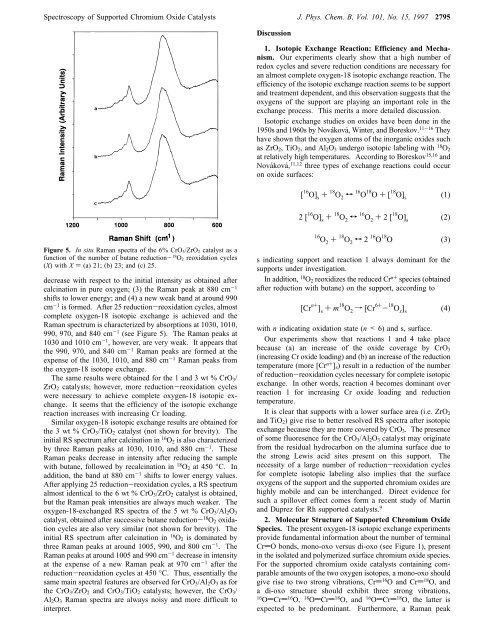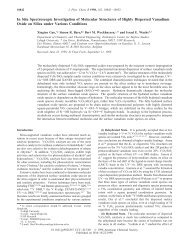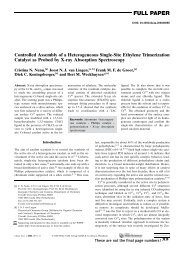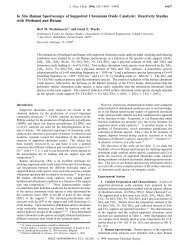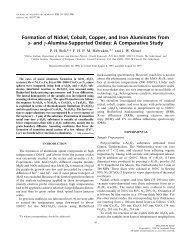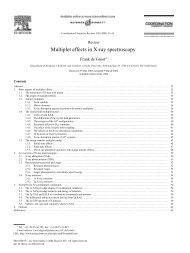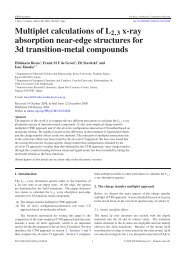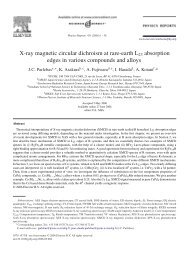View - Inorganic Chemistry and Catalysis
View - Inorganic Chemistry and Catalysis
View - Inorganic Chemistry and Catalysis
Create successful ePaper yourself
Turn your PDF publications into a flip-book with our unique Google optimized e-Paper software.
Spectroscopy of Supported Chromium Oxide Catalysts J. Phys. Chem. B, Vol. 101, No. 15, 1997 2795<br />
Discussion<br />
1. Isotopic Exchange Reaction: Efficiency <strong>and</strong> Mechanism.<br />
Our experiments clearly show that a high number of<br />
redox cycles <strong>and</strong> severe reduction conditions are necessary for<br />
an almost complete oxygen-18 isotopic exchange reaction. The<br />
efficiency of the isotopic exchange reaction seems to be support<br />
<strong>and</strong> treatment dependent, <strong>and</strong> this observation suggests that the<br />
oxygens of the support are playing an important role in the<br />
exchange process. This merits a more detailed discussion.<br />
Isotopic exchange studies on oxides have been done in the<br />
1950s <strong>and</strong> 1960s by Nováková, Winter, <strong>and</strong> Boreskov. 11-16 They<br />
have shown that the oxygen atoms of the inorganic oxides such<br />
as ZrO 2 , TiO 2 , <strong>and</strong> Al 2 O 3 undergo isotopic labeling with 18 O 2<br />
at relatively high temperatures. According to Boreskov 15,16 <strong>and</strong><br />
Nováková, 11,12 three types of exchange reactions could occur<br />
on oxide surfaces:<br />
[ 16 O] s + 18 O 2 T 16 O 18 O + [ 18 O] s (1)<br />
2[ 16 O] s + 18 O 2 T 16 O 2 + 2[ 18 O] s (2)<br />
16 O 2 + 18 O 2 T 2 16 O 18 O (3)<br />
Figure 5. In situ Raman spectra of the 6% CrO 3/ZrO 2 catalyst as a<br />
function of the number of butane reduction- 18 O 2 reoxidation cycles<br />
(X) with X ) (a) 21; (b) 23; <strong>and</strong> (c) 25.<br />
decrease with respect to the initial intensity as obtained after<br />
calcination in pure oxygen; (3) the Raman peak at 880 cm -1<br />
shifts to lower energy; <strong>and</strong> (4) a new weak b<strong>and</strong> at around 990<br />
cm -1 is formed. After 25 reduction-reoxidation cycles, almost<br />
complete oxygen-18 isotopic exchange is achieved <strong>and</strong> the<br />
Raman spectrum is characterized by absorptions at 1030, 1010,<br />
990, 970, <strong>and</strong> 840 cm -1 (see Figure 5). The Raman peaks at<br />
1030 <strong>and</strong> 1010 cm -1 , however, are very weak. It appears that<br />
the 990, 970, <strong>and</strong> 840 cm -1 Raman peaks are formed at the<br />
expense of the 1030, 1010, <strong>and</strong> 880 cm -1 Raman peaks from<br />
the oxygen-18 isotope exchange.<br />
The same results were obtained for the 1 <strong>and</strong> 3 wt % CrO 3 /<br />
ZrO 2 catalysts; however, more reduction-reoxidation cycles<br />
were necessary to achieve complete oxygen-18 isotopic exchange.<br />
It seems that the efficiency of the isotopic exchange<br />
reaction increases with increasing Cr loading.<br />
Similar oxygen-18 isotopic exchange results are obtained for<br />
the3wt%CrO 3 /TiO 2 catalyst (not shown for brevity). The<br />
initial RS spectrum after calcination in 16 O 2 is also characterized<br />
by three Raman peaks at 1030, 1010, <strong>and</strong> 880 cm -1 . These<br />
Raman peaks decrease in intensity after reducing the sample<br />
with butane, followed by recalcination in 18 O 2 at 450 °C. In<br />
addition, the b<strong>and</strong> at 880 cm -1 shifts to lower energy values.<br />
After applying 25 reduction-reoxidation cycles, a RS spectrum<br />
almost identical to the 6 wt % CrO 3 /ZrO 2 catalyst is obtained,<br />
but the Raman peak intensities are always much weaker. The<br />
oxygen-18-exchanged RS spectra of the 5 wt % CrO 3 /Al 2 O 3<br />
catalyst, obtained after successive butane reduction- 18 O 2 oxidation<br />
cycles are also very similar (not shown for brevity). The<br />
initial RS spectrum after calcination in 16 O 2 is dominated by<br />
three Raman peaks at around 1005, 990, <strong>and</strong> 800 cm -1 . The<br />
Raman peaks at around 1005 <strong>and</strong> 990 cm -1 decrease in intensity<br />
at the expense of a new Raman peak at 970 cm -1 after the<br />
reduction-reoxidation cycles at 450 °C. Thus, essentially the<br />
same main spectral features are observed for CrO 3 /Al 2 O 3 as for<br />
the CrO 3 /ZrO 2 <strong>and</strong> CrO 3 /TiO 2 catalysts; however, the CrO 3 /<br />
Al 2 O 3 Raman spectra are always noisy <strong>and</strong> more difficult to<br />
interpret.<br />
s indicating support <strong>and</strong> reaction 1 always dominant for the<br />
supports under investigation.<br />
In addition, 18 O 2 reoxidizes the reduced Cr n+ species (obtained<br />
after reduction with butane) on the support, according to<br />
[Cr n+ ] s + m 18 O 2 f [Cr 6+ - 18 O x ] s (4)<br />
with n indicating oxidation state (n < 6) <strong>and</strong> s, surface.<br />
Our experiments show that reactions 1 <strong>and</strong> 4 take place<br />
because (a) an increase of the oxide coverage by CrO 3<br />
(increasing Cr oxide loading) <strong>and</strong> (b) an increase of the reduction<br />
temperature (more [Cr n+ ] s ) result in a reduction of the number<br />
of reduction-reoxidation cycles necessary for complete isotopic<br />
exchange. In other words, reaction 4 becomes dominant over<br />
reaction 1 for increasing Cr oxide loading <strong>and</strong> reduction<br />
temperature.<br />
It is clear that supports with a lower surface area (i.e. ZrO 2<br />
<strong>and</strong> TiO 2 ) give rise to better resolved RS spectra after isotopic<br />
exchange because they are more covered by CrO 3 . The presence<br />
of some fluoresence for the CrO 3 /Al 2 O 3 catalyst may originate<br />
from the residual hydrocarbon on the alumina surface due to<br />
the strong Lewis acid sites present on this support. The<br />
necessity of a large number of reduction-reoxidation cycles<br />
for complete isotopic labeling also implies that the surface<br />
oxygens of the support <strong>and</strong> the supported chromium oxides are<br />
highly mobile <strong>and</strong> can be interchanged. Direct evidence for<br />
such a spillover effect comes form a recent study of Martin<br />
<strong>and</strong> Duprez for Rh supported catalysts. 9<br />
2. Molecular Structure of Supported Chromium Oxide<br />
Species. The present oxygen-18 isotopic exchange experiments<br />
provide fundamental information about the number of terminal<br />
CrdO bonds, mono-oxo versus di-oxo (see Figure 1), present<br />
in the isolated <strong>and</strong> polymerized surface chromium oxide species.<br />
For the supported chromium oxide catalysts containing comparable<br />
amounts of the two oxygen isotopes, a mono-oxo should<br />
give rise to two strong vibrations, Crd 16 O <strong>and</strong> Crd 18 O, <strong>and</strong><br />
a di-oxo structure should exhibit three strong vibrations,<br />
16 OdCrd 16 O, 18 OdCrd 18 O, <strong>and</strong> 16 OdCrd 18 O, the latter is<br />
expected to be predominant. Furthermore, a Raman peak


